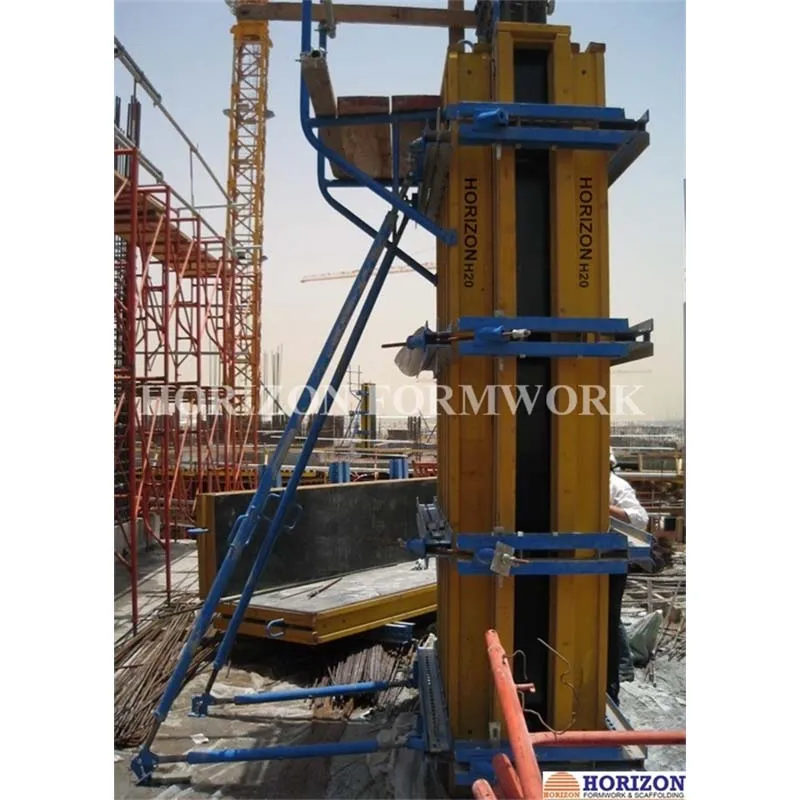May . 08, 2025 13:41 Back to list
Column Formwork Systems: Building Stronger Vertical Structures with Precision
In reinforced concrete construction, columns play a critical structural role, transferring loads from slabs and beams down to the foundation. To ensure quality, strength, and speed during casting, using the right column formwork system is essential.

Whether you’re constructing standard square columns or architecturally complex curved ones, having the right formwork solution — from circular column formwork to curved column formwork — directly impacts the efficiency, finish, and safety of your project.
This guide explains the types, benefits, and best practices for choosing and using column formwork systems in commercial, industrial, and infrastructure construction.
What Is Column Formwork?
Column formwork refers to the temporary or reusable mold system used to shape and support wet concrete as it sets into a vertical column. These systems are engineered to withstand the hydrostatic pressure of fresh concrete while maintaining the column’s dimensions, alignment, and finish quality.
Formwork for columns is typically:
Reusable (steel, aluminum, plastic) or single-use (plywood, cardboard)
Designed for quick assembly and stripping
Adjustable for different heights and cross-sections
Column formwork systems vary depending on the column shape: rectangular, circular, elliptical, or custom curved.
Types of Column Formwork
1. Rectangular and Square Column Formwork
Most common in commercial buildings and infrastructure
Made from steel frames with plywood or aluminum face
Modular panels that can be reused on multiple floors
2. Circular Column Formwork
Circular column formwork is used to create round or cylindrical concrete columns, common in parking structures, bridges, or architectural features.
Key characteristics:
Made from curved steel, plastic, or high-strength cardboard (e.g., sonotube)
Provides smooth, uniform circular surfaces
Available in adjustable or fixed diameters
Can be pre-assembled or site-built depending on diameter and project scale
3. Curved Column Formwork
Curved column formwork refers to systems that can form non-circular, non-rectilinear shapes — such as elliptical, spiral, or custom architectural forms.
Ideal for:
Decorative columns in lobbies or facades
Theaters, museums, or landmark buildings
Complex infrastructure like viaduct supports
This type often uses flexible plywood, laminated panels, or CNC-formed steel molds, depending on the required radius and finish.
Benefits of Modern Column Formwork Systems
✅ Improved surface quality – Especially for circular and architectural columns
✅ Faster setup and stripping – Pre-assembled or modular panels reduce cycle time
✅ Reusability – Steel and aluminum systems can be reused 50–100+ times
✅ Better alignment and tolerances – Ensures structural accuracy
✅ Labor savings – Quick-lock systems reduce on-site labor needs
✅ Enhanced safety – Bracing systems and lifting hooks prevent accidents
Choosing the Right Column Formwork
|
Factor |
Recommendation |
|
Column shape |
Use circular column formwork for round profiles, curved for custom forms |
|
Height and diameter |
Ensure panels or tubes can be joined or adjusted as needed |
|
Surface finish required |
Steel or plastic-faced formwork provides the best surface |
|
Reusability needs |
Go for steel/aluminum for long-term use; cardboard for one-offs |
|
Access to crane or lifting |
Larger column forms may need crane-lifting features |
Materials Used in Column Formwork
Steel – Durable, smooth finish, ideal for high reusability and large loads
Aluminum – Lightweight alternative to steel, corrosion-resistant
Plywood with frame – Economical, reusable a limited number of times
Plastic – Lightweight, clean finish, great for architectural concrete
Cardboard tubes (Sonotube) – Cost-effective for small circular columns; single-use
Installation and Assembly of Circular and Curved Column Formwork
Circular column formwork typically includes:
Two semicircular halves joined with clamps or bolts
Inner tie rods or external stiffeners
Adjustable base rings for height variation
Curved column formwork may require:
Custom-manufactured molds
CNC shaping for complex contours
High-precision bracing and alignment systems
Proper bracing, shoring, and vertical alignment are critical to avoid bulging or shifting during concrete pour.
Applications of Curved and Circular Columns
Circular columns are widely used in:
Multi-level car parks
Bridges and highway supports
Airport terminals and high-rise cores
Curved column formwork supports design-forward construction such as:
Curved facade supports
Artistic or architectural pillars
Infrastructure requiring aerodynamic or space-saving shapes
Column Formwork FAQs
Q1: What’s the difference between circular and curved column formwork?
A: Circular formwork is used for round columns with consistent diameter. Curved formwork refers to more complex, non-circular shapes like ellipses or spirals.
Q2: Can I reuse cardboard circular column formwork?
A: No. Cardboard tubes are usually single-use and removed by cutting after the concrete has cured.
Q3: How tall can I cast a column in one pour?
A: It depends on the formwork's pressure rating. Typically 3–4 meters per pour, but special systems can support more with careful planning.
Q4: Can curved column formwork be rented?
A: Standard circular formwork is often available for rent. Custom curved solutions usually need to be purchased or fabricated per project.
Q5: Is curved column formwork worth the extra cost?
A: For architectural projects, yes. It enables unique design elements and a high-end finish that traditional forms can’t replicate.
From simple structural cores to bold architectural features, column formwork plays a central role in vertical concrete construction. Whether you're working on a high-rise, a bridge, or a design-driven facade, selecting the right formwork — be it circular column formwork for round pillars or curved column formwork for custom shapes — ensures you hit both structural and aesthetic targets.
-
Timber Beam H20 for Agricultural Buildings
WartaJul.21,2025
-
Tie Rod Concrete Formwork for Bridge Construction
WartaJul.21,2025
-
Table Formwork for Slab Edge Protection
WartaJul.21,2025
-
Load Calculations for Wall Formwork System
WartaJul.21,2025
-
Concrete Column Form Work Systems Productivity Tips
WartaJul.21,2025
-
Beam Slab Formwork for Ribbed Slabs
WartaJul.21,2025